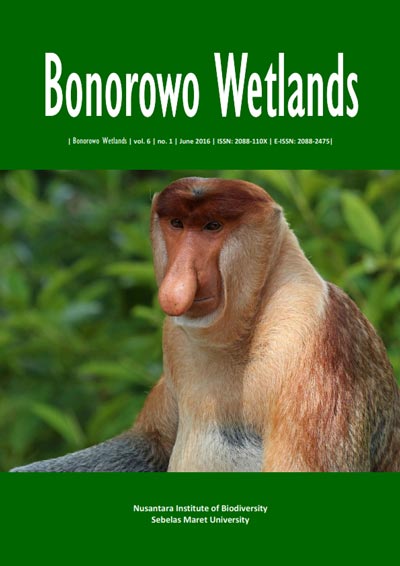Degradation analysis of mangrove ecological function as macrozoobenthos habitat and its management in the Angke Kapuk Coastal Area, Jakarta
##plugins.themes.bootstrap3.article.main##
Abstract
Abstract. Bayan IE, Yulianda F, Isdradjad Setyobudiandi I. 2016. Degradation analysis of mangrove ecological function as macrozoobenthos habitat and its management in the Angke Kapuk Coastal Area, Jakarta. Bonorowo Wetlands 6: 1-11. Mangrove ecosystem is a natural resource that has many ecological benefits in the coastal ecosystems, such as becoming the habitat and food source for terrestrial and marine biotas. One of the Indonesian territories which has a fairly large mangrove forest area is in the north of DKI Jakarta Province. That is Angke Kapuk coastal which has 327.70 hectares of green belt area and is scattered in several regions (BKSDA Jakarta, 2003). Mangrove areas in Angke Kapuk play some important roles in the ecosystem, such as becoming a preservation habitat for several species, especially macrozoobenthos. The environmental degradation along with regional development, such as tourism, fisheries activity, and industrial caused the coastal resources of mangrove areas to become vulnerable. The purpose of this study was to analyze the ecological functions of mangroves as the habitat of macrozoobenthos in Angke Kapuk coastal region, to determine the extent of damage to mangrove state and its sustainable management recommendation of mangrove ecosystems in the Angke Kapuk coastal region. This study was conducted in June 2013 and March 2014 at six different stations based on the representation of the condition on the study site. The data collection consists of macrozoobenthos data collection and measurement of water quality parameters, including turbidity, DO, COD, BOD, salinity, pH, nitrate (NO3-N), nitrite (NO2-N), orthophosphate (PO4-P), and solids suspended (TSS). The results showed that the macrozoobenthos habitat and ecological functions of coastal mangrove areas in Angke Kapuk were degraded. The state of mangroves ecology in coastal Angke Kapuk was in the damage category based on standard mangrove destruction criteria of Minister of Environment’s Decree Number 201 of 2004. The mangrove density was less than 1,000 trees/ha, and its coverage area was less than 50%, so rehabilitation efforts involving the community and manager sectors for the mangrove area sustainability are necessary. Habitat improvement can be applied through cleaning trash in mangrove areas, especially in group A stations that be the most degraded condition and the largest receiving environmental pressures, as well as the group B stations which potentially fall on ecological function degradation due to high development pressures. Planting mangroves vegetation on the site that is ready to be planted is another way to improve the habitat.

